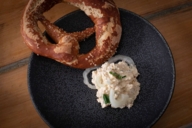
You know them from the beer garden or the Oktoberfest: the giant pretzels with homemade Obazdem. Here you will not only learn everything you need to know about the Munich pretzel, but also get the original recipe from our chef Sven Christ.
For the pre-dough, dissolve the yeast in lukewarm water and mix with the flour in a bowl to form a homogeneous mass. Leave the pre-dough to rise in a warm place for one hour, covered with a kitchen towel. Dissolve the rest of the yeast in the lukewarm milk and put it in a bowl with all other ingredients and the pre-dough. Knead together using the dough hook mixer attachment for ten minutes on a low setting to create a medium-firm dough, then continue kneading for another two minutes on the highest setting. Then cover the dough with a kitchen towel and let it rest for ten minutes.
Divide the dough into ten equal pieces of 80 g each or into two or three pieces of the same size. Then form the dough pieces into long strands, finger-thick in the middle and thin towards the ends – for giant pretzels, these should be thicker overall.
Now pull the two ends towards you and wrap them around each other once, and place the ends on the sides of the resulting arch. Now the pretzels should have the right shape; to be on the safe side, you can compare them with a picture – sometimes this only works the third time around.
Let the pretzels prove for another 25 minutes and then put them in the fridge to dry for 15 minutes. Then dip them one after the other in the lye solution (with gloves) and place them on a baking tray lined with baking paper. Slightly score the thick middle part with a sharp knife and sprinkle the pretzels with coarse salt.
Preheat the oven to 240 degrees. When the pretzels are in the oven, reduce the temperature to 200 degrees. Bake the pretzels for 16 to 18 minutes until chestnut brown.
Tip: make double the amount of dough and freeze the unbaked pretzels and bake them as and when needed.
Peel and finely dice the onion and roughly dice the cheese. Finely chop the cheese and onions on a board together with the cream cheese, marjoram and chives until a homogeneous mass is achieved. Place the cheese mixture into a bowl and mix with vinegar, beer, horseradish and the spices before seasoning to taste. Finely cut the spring onion and sprinkle over the obazden.
One baked product that has become such an integral part of Munich's culture is the pretzel. It is the symbol for Munich par excellence. Even as children, Munich residents are handed one as soon as they can hold it. The shape of the pretzel is supposed to represent a praying monk (you should know that some monks cross their arms in front of their chest for prayer).
“Sharing is caring“ is a slogan from the social media era, and a concept warmly embraced in Munich's beer garden, where big pretzels are sold, and which you can hardly manage on your own.
Its second characteristic feature, the chestnut brown colour, is due to a historically documented accident: A baker's apprentice accidentally dropped a piece of bread into a bucket of caustic soda and baked it anyway. That's how this Munich pastry came to be, which has successfully made its way into the world beyond the city limits, but which is usually eaten warm and with mustard (which, by the way, is rather improper).
“Sharing is caring“ is a slogan from the social media era, and a concept warmly embraced in Munich's beer garden, where big pretzels are sold, and which you can hardly manage on your own. But there is almost always someone from the group who orders a pretzel, and anyone can break off a piece of it – a thought that, after weeks of social distancing, now frequently triggers a mixture of feelings ranging from horror to longing.
Those who find the idea of sharing a giant pretzel too risky, even among their own household members, can of course make do with small pretzels as an exception. The perfect accompaniment for this is always an Obazda (spicy cheese delicacy), a relatively unknown speciality from Bavaria, which has not yet been able to establish itself internationally because of its name and rather acquired taste.
To bake your own pretzels, you first have to go to the pharmacy and buy a food-grade lye solution; sometimes this is available in undiluted form, but you have to be careful when processing it, and be sure to wear glasses and gloves. Or better still, buy the diluted version with three percent to one litre of water.
I will never forget the face of my Italian girlfriend, who thought she was in possession of a freshly bought “salmon cream”. Obazda is a creamy mass made of different kinds of cheese, and it comes in many different variations. What unites all the varieties are the basic taste and its consistency. In any case, it’s an ideal “dip” to go with pretzels and beer, a Bavarian guacamole so to speak – that's probably the best way to describe it.
The Obazda is made from onion, chopped camembert or soft- and cream cheese, with herbs and a shot of beer for creaminess. From here on, creativity takes centre stage, leaving you to add wild garlic if the season calls for it, for example; the great and the good of Munich also like a hint of truffle, while the older echelons of society tend to like adding a sprinkle of paprika powder, although I suspect that this variation is a culinary relic of the seventies.